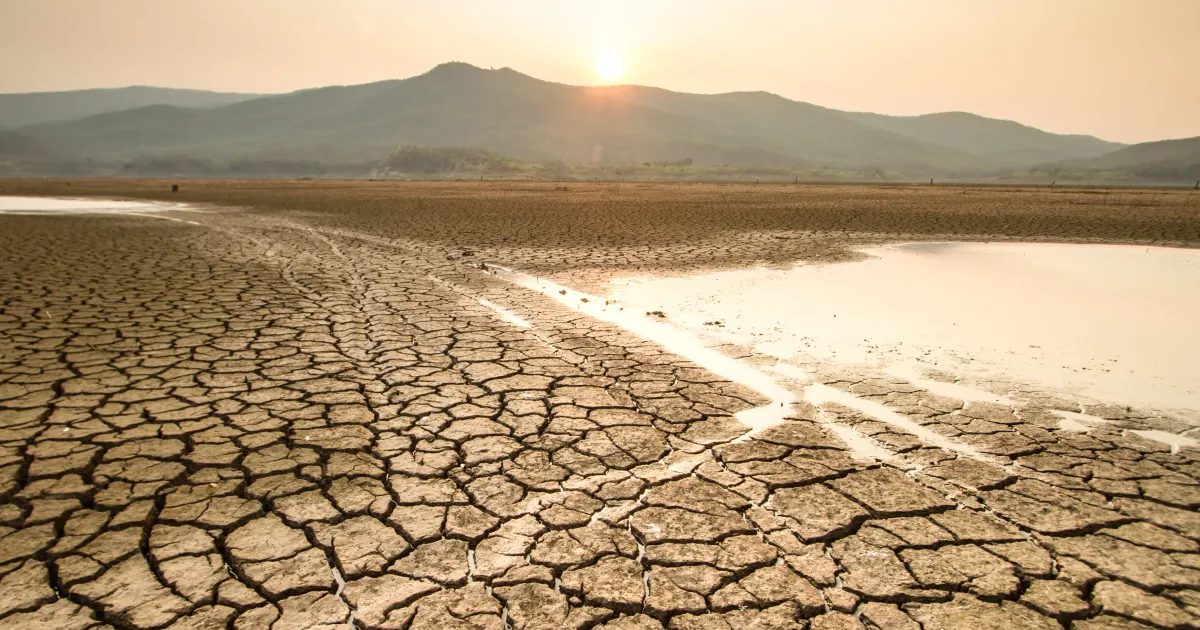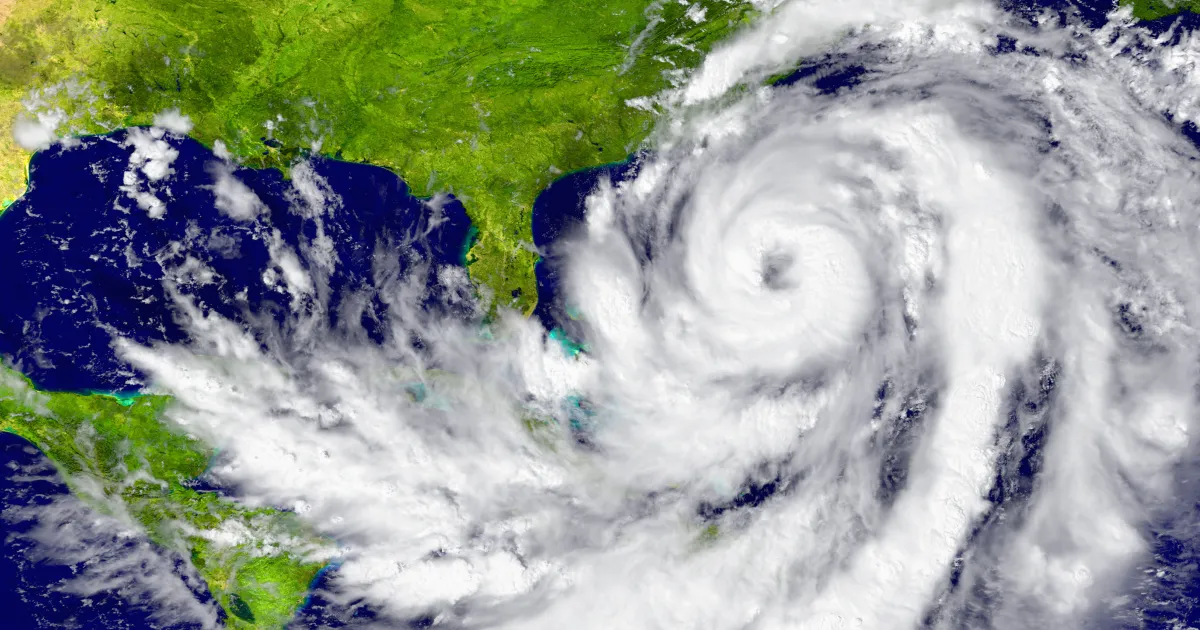Navigate the top climate change issues set to impact the supply chain in 2024.
2023 was the warmest year on record. Now, it is predicted that 2024 has a 99% chance of ranking in the top five warmest years. As temperatures continue to rise, the intersection of climate change and supply chain resilience demands increased attention from businesses worldwide. From wildfires to hurricanes, the potential for climate-related supply chain disruptions remains a significant concern for supply chains and economies globally.

A graph showing Resilinc’s Extreme Weather Trends data from 2012 to 2023. While all disruptions show increased growth, Extreme Weather disruptions saw a significant jump from 2020 to 2023.
In fact, Resilinc’s CEO, Bindiya Vakil, named Climate Change as one of the top five supply chain megatrends for 2024. Data from Resilinc’s 24/7, AI-powered supply chain monitoring platform EventWatchAI supports this trend. From 2021 to 2023, the platform saw a 44% increase in alerts related to extreme weather—growing from 244 disruptions in 2021 to 351 this past year. With more disruptions on the horizon, we’ve laid out the key climate change issues for 2024 in this blog with practical insights and strategies to navigate these challenges.

Record-breaking temperatures in 2023 exacerbated global droughts. According to the Global Drought Snapshot report for 2023 published by the UN Convention to Combat Desertification (UNCCD), data from the past two years shows that drought is one of the most severe problems we face. In 2023, global temperatures rose 1.18°C (34.1°F) above preindustrial levels. If that number reaches 1.5°C (34.7°F), the report projects 120 million people worldwide will experience extreme drought.
The U.S. Geological Survey agrees that droughts are a major problem stating, “Climate change has further altered the natural pattern of droughts, making them more frequent, longer, and more severe.” Many sectors are affected by droughts, including agriculture, energy, water, utilities, and manufacturing. Here’s a look at two recent major droughts that have impacted supply chains:
In 2023, the Panama Canal, one of the world’s most important waterways, faced one of the driest years in over 140 years. Water shortages burdened Panama Canal shippers with extraordinary delays and cost increases, serving as a reminder to greater consider changing climate and weather patterns in supplier contracting and logistics planning. For now, the Panama Canal has eased until April 2024—allowing 24 vessels to pass through per day. In April, the Panama Canal Authority will reevaluate water levels. If rain arrives in May as expected, the canal plans to increase daily slots with a goal of returning to 36 vessels per day.
The Yangtze River Basin, home to Asia’s longest river, boasts a staggering annual cargo volume of over 3 billion tonnes. However, low rainfall and rising temperatures have accelerated evaporation, causing water levels in the river to plummet. In August 2022, these water levels fell to 60% below average, marketing the lowest levels seen since 1865. This drought impacted hydropower, disrupted shipping, and affected five million people in southern China, according to the World Meteorological Organization.

El Niño, a cyclical climate pattern characterized by warmer waters in the Pacific Ocean, is expected to have significant implications for global supply chains in 2024. Returning after four years, El Niño is predicted to peak in the first half of the year, leading to extreme weather conditions like heavy rainfall, flooding, and storms. These conditions could potentially impact supply chain logistics and transportation by sea, air, and land.
While the system often brings heavy rainfall to the Southern US and Mexico, this can result in drought in other regions such as Australia, Indonesia, parts of southern Asia, and Central and West Africa. As a result, this could lead to crop failures and affect the availability and pricing of some agricultural products. Delicate crops such as sugar, rice, and wine grapes are especially at risk of being affected by outlier conditions in 2024. Learn more about the effects of El Nino and what you can do to prepare your supply chain in our white paper: El Nino Supply Chain Impact Analysis.

Hurricanes are another extreme weather event that can impact global supply chains, resulting in lost or delayed shipments, port disruptions, canceled cargo flights, and unbalanced supply and demand. For example, in 2022, Hurricane Ian damaged more than $416 million in citrus crops in Florida—half of all citrus consumers by Americans.
According to the National Oceanic and Atmospheric Administration (NOAA) the 2023 Atlantic hurricane season ranked fourth for most-named storms in a year. Will 2024 continue this trend with El Niño on the way? This year, Hurricane season is set to last from June 1 through November 30.

Wildfires, often fueled by climate change-induced droughts, pose a threat to global supply chains in 2024. With record-breaking wildfires scorching millions of acres in North America—particularly in Canada, where over 42 million acres were burned in 2023—the impact on logistics, transportation networks, and overall business operations has the potential to be significant. Forest fires globally are burning nearly twice as much tree cover compared to two decades ago, exacerbating supply chain disruptions with extensive delays and expenses.
Climate change is expected to worsen droughts and wildfires in many regions. Global cotton supplies are considered especially vulnerable to worsening droughts, heat waves, and wildfires, according to an analysis by climate risk consultancy Acclimatise. The Cotton 2040 report finds that half of global cotton-producing regions will be at greater risk by 2040. While cotton is only a $12 billion industry, it makes up 31% of raw materials used in the textile and apparel industries, which have a global economic impact of $600 billion. Although fire seasons are starting earlier and lasting longer in many regions, there is still seasonality to fire risk, which allows for proactive risk mitigations.
Hurricanes, droughts, floods, and wildfires are escalating, posing significant challenges to infrastructure, economies, and livelihoods worldwide. The drought in the Panama Canal underscores the repercussions of climate change on critical global trade routes. Water scarcity also poses significant risks, driving down crop yields and escalating food prices while exacerbating socio-economic disparities and geopolitical tensions, as seen in conflicts over water resources among nations like Turkey, Syria, and Iraq. It also threatens semiconductor production, with a single fab requiring millions of gallons of water daily.
Such incidents are warning signs of a future where climate-related disruptions become the norm. Ignoring this reality puts supply chains at increasing financial risk, with the World Bank estimating climate change could cost developing countries $500 billion annually by 2050. Geopolitical cooperation is crucial in tackling climate change, evidenced by initiatives like the Paris Agreement binding 196 countries since 2015. Despite domestic efforts such as the US Inflation Reduction Act promoting renewable energy investment, challenges persist, representing ongoing risks in the year ahead.
Building resilience requires proactive measures like investing in supply chain risk management programs and technology. Businesses that recognize the climate threat and actively mitigate it won’t just be safeguarding their operations—they’ll be gaining a competitive edge in a world increasingly grappling with the consequences of a changing climate.
This starts with mapping sites across the world that supply your business—several tiers below your direct suppliers. Mapping is a resource- and time-intensive activity, but Resilinc’s hybrid approach to Multi-Tier Mapping can streamline the process for your company.
Then, identify suppliers and sites that are essential to your company’s highest revenue solutions and initiate risk assessments focused on those sites with services and a dive into historical climate and supplier performance data. This will help uncover the extent of previous weather-related disruptions and the climate trends for a particular site or region. Want to learn more about how Resilinc can help your company become more resilient in the face of climate change? Elevate your supply chain risk and resiliency program: Request a demo today.
The post How Will Climate Change Impact Supply Chains in 2024? appeared first on Resilinc.
2023 was the warmest year on record. Now, it is predicted that 2024 has a 99% chance of ranking in the top five warmest years. As temperatures continue to rise, the intersection of climate change and supply chain resilience demands increased attention from businesses worldwide. From wildfires to hurricanes, the potential for climate-related supply chain disruptions remains a significant concern for supply chains and economies globally.

A graph showing Resilinc’s Extreme Weather Trends data from 2012 to 2023. While all disruptions show increased growth, Extreme Weather disruptions saw a significant jump from 2020 to 2023.
In fact, Resilinc’s CEO, Bindiya Vakil, named Climate Change as one of the top five supply chain megatrends for 2024. Data from Resilinc’s 24/7, AI-powered supply chain monitoring platform EventWatchAI supports this trend. From 2021 to 2023, the platform saw a 44% increase in alerts related to extreme weather—growing from 244 disruptions in 2021 to 351 this past year. With more disruptions on the horizon, we’ve laid out the key climate change issues for 2024 in this blog with practical insights and strategies to navigate these challenges.
1. Drought

Record-breaking temperatures in 2023 exacerbated global droughts. According to the Global Drought Snapshot report for 2023 published by the UN Convention to Combat Desertification (UNCCD), data from the past two years shows that drought is one of the most severe problems we face. In 2023, global temperatures rose 1.18°C (34.1°F) above preindustrial levels. If that number reaches 1.5°C (34.7°F), the report projects 120 million people worldwide will experience extreme drought.
The U.S. Geological Survey agrees that droughts are a major problem stating, “Climate change has further altered the natural pattern of droughts, making them more frequent, longer, and more severe.” Many sectors are affected by droughts, including agriculture, energy, water, utilities, and manufacturing. Here’s a look at two recent major droughts that have impacted supply chains:
Panama Canal Drought Impact on Supply Chain
In 2023, the Panama Canal, one of the world’s most important waterways, faced one of the driest years in over 140 years. Water shortages burdened Panama Canal shippers with extraordinary delays and cost increases, serving as a reminder to greater consider changing climate and weather patterns in supplier contracting and logistics planning. For now, the Panama Canal has eased until April 2024—allowing 24 vessels to pass through per day. In April, the Panama Canal Authority will reevaluate water levels. If rain arrives in May as expected, the canal plans to increase daily slots with a goal of returning to 36 vessels per day.
Drought in China Impact on Supply Chain
The Yangtze River Basin, home to Asia’s longest river, boasts a staggering annual cargo volume of over 3 billion tonnes. However, low rainfall and rising temperatures have accelerated evaporation, causing water levels in the river to plummet. In August 2022, these water levels fell to 60% below average, marketing the lowest levels seen since 1865. This drought impacted hydropower, disrupted shipping, and affected five million people in southern China, according to the World Meteorological Organization.
2. El Nino

El Niño, a cyclical climate pattern characterized by warmer waters in the Pacific Ocean, is expected to have significant implications for global supply chains in 2024. Returning after four years, El Niño is predicted to peak in the first half of the year, leading to extreme weather conditions like heavy rainfall, flooding, and storms. These conditions could potentially impact supply chain logistics and transportation by sea, air, and land.
While the system often brings heavy rainfall to the Southern US and Mexico, this can result in drought in other regions such as Australia, Indonesia, parts of southern Asia, and Central and West Africa. As a result, this could lead to crop failures and affect the availability and pricing of some agricultural products. Delicate crops such as sugar, rice, and wine grapes are especially at risk of being affected by outlier conditions in 2024. Learn more about the effects of El Nino and what you can do to prepare your supply chain in our white paper: El Nino Supply Chain Impact Analysis.
3. Hurricane Season

Hurricanes are another extreme weather event that can impact global supply chains, resulting in lost or delayed shipments, port disruptions, canceled cargo flights, and unbalanced supply and demand. For example, in 2022, Hurricane Ian damaged more than $416 million in citrus crops in Florida—half of all citrus consumers by Americans.
According to the National Oceanic and Atmospheric Administration (NOAA) the 2023 Atlantic hurricane season ranked fourth for most-named storms in a year. Will 2024 continue this trend with El Niño on the way? This year, Hurricane season is set to last from June 1 through November 30.
4. Wildfires and Forest Fires

Wildfires, often fueled by climate change-induced droughts, pose a threat to global supply chains in 2024. With record-breaking wildfires scorching millions of acres in North America—particularly in Canada, where over 42 million acres were burned in 2023—the impact on logistics, transportation networks, and overall business operations has the potential to be significant. Forest fires globally are burning nearly twice as much tree cover compared to two decades ago, exacerbating supply chain disruptions with extensive delays and expenses.
Climate change is expected to worsen droughts and wildfires in many regions. Global cotton supplies are considered especially vulnerable to worsening droughts, heat waves, and wildfires, according to an analysis by climate risk consultancy Acclimatise. The Cotton 2040 report finds that half of global cotton-producing regions will be at greater risk by 2040. While cotton is only a $12 billion industry, it makes up 31% of raw materials used in the textile and apparel industries, which have a global economic impact of $600 billion. Although fire seasons are starting earlier and lasting longer in many regions, there is still seasonality to fire risk, which allows for proactive risk mitigations.
Outlook for 2024: Impact of Climate Change on the Supply Chain
Hurricanes, droughts, floods, and wildfires are escalating, posing significant challenges to infrastructure, economies, and livelihoods worldwide. The drought in the Panama Canal underscores the repercussions of climate change on critical global trade routes. Water scarcity also poses significant risks, driving down crop yields and escalating food prices while exacerbating socio-economic disparities and geopolitical tensions, as seen in conflicts over water resources among nations like Turkey, Syria, and Iraq. It also threatens semiconductor production, with a single fab requiring millions of gallons of water daily.
Such incidents are warning signs of a future where climate-related disruptions become the norm. Ignoring this reality puts supply chains at increasing financial risk, with the World Bank estimating climate change could cost developing countries $500 billion annually by 2050. Geopolitical cooperation is crucial in tackling climate change, evidenced by initiatives like the Paris Agreement binding 196 countries since 2015. Despite domestic efforts such as the US Inflation Reduction Act promoting renewable energy investment, challenges persist, representing ongoing risks in the year ahead.
What can your company do to become more resilient to climate change?
Building resilience requires proactive measures like investing in supply chain risk management programs and technology. Businesses that recognize the climate threat and actively mitigate it won’t just be safeguarding their operations—they’ll be gaining a competitive edge in a world increasingly grappling with the consequences of a changing climate.
This starts with mapping sites across the world that supply your business—several tiers below your direct suppliers. Mapping is a resource- and time-intensive activity, but Resilinc’s hybrid approach to Multi-Tier Mapping can streamline the process for your company.
Then, identify suppliers and sites that are essential to your company’s highest revenue solutions and initiate risk assessments focused on those sites with services and a dive into historical climate and supplier performance data. This will help uncover the extent of previous weather-related disruptions and the climate trends for a particular site or region. Want to learn more about how Resilinc can help your company become more resilient in the face of climate change? Elevate your supply chain risk and resiliency program: Request a demo today.
The post How Will Climate Change Impact Supply Chains in 2024? appeared first on Resilinc.
